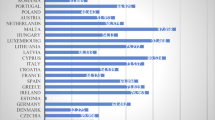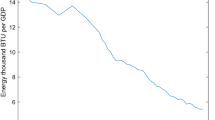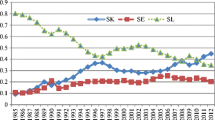Abstract
This paper empirically investigates the development of cross-country differences in energy- and labour productivity. The analysis is performed at a detailed sectoral level for 14 OECD countries, covering the period 1970–1997. A σ-convergence analysis reveals that the development over time of the cross-country variation in productivity performance differs across sectors as well as across different levels of aggregation. Both patterns of convergence as well as divergence are found. Cross-country variation of productivity levels is typically larger for energy than for labour. A β-convergence analysis provides support for the hypothesis that in most sectors lagging countries tend to catch up with technological leaders, in particular in terms of energy productivity. Moreover, the results show that convergence is conditional, meaning that productivity levels converge to country-specific steady states. Energy prices and wages are shown to positively affect energy- and labour-productivity growth, respectively. We also find evidence for the importance of economies of scale, whereas the investment share, openness and specialization play only a modest role in explaining cross-country variation in energy- and labour-productivity growth.
Similar content being viewed by others
References
Abramovitz M. (1986) Catching Up, Forging Ahead, and Falling Behind. Journal of Economic History 47:385–406
Abreu M., de Groot H.L.F., Florax R.J.G.M. (2005) A Meta-Analysis of β-Convergence: The Legendary 2%. Journal of Economic Surveys 19(3):389–420
Barro R.J. (1991) Economic Growth in a Cross-Section of Countries. Quarterly Journal of Economics 106:407–443
Barro R.J., Sala-i-Martin X. (1992) Convergence. Journal of Political Economy 100:223–251
Barro R.J., Sala-i-Martin X. (1995) Economic Growth. New York, McGraw Hill
Bernard A.B., Jones C.I. (1996a) Comparing Apples to Oranges: Productivity Convergence and Measurement across Industries and Countries. American Economic Review 86:1216–1238
Bernard A.B., Jones C.I. (1996b) Productivity across Industries and Countries: Time Series Theory and Evidence. Review of Economics and Statistics 78:135–146
Bernard A.B., Jones C.I. (2001) Comparing Apples to Oranges: Productivity Convergence and Measurement across Industries and Countries: Reply. American Economic Review 91:1168–1169
Bernard A.B., Durlauf S.N. (1996) Interpreting Tests of the Convergence Hypothesis. Journal of Econometrics 71:161–173
Berndt E.R. (1978) Aggregate Energy, Efficiency, and Productivity Measurement. Annual Review of Energy 3:225–273
Broadberry S.N. (1996) Convergence: What the Historical Record Shows. In: vanArk B., Crafts N. (eds), Quantitative Aspects of Post-War European Growth. Cambridge University Press, Cambridge
Brock W.A., Taylor M.S. (2004) The Green Solow Model, NBER Working Paper 10557. Cambridge, MA
Chamberlain G. (1982) Multivariate Regression Models for Panel Data. Journal of Econometrics 18:5–46
Chatterji M. (1992) Convergence Clubs and Endogenous Growth. Oxford Review of Economic Policy 8:57–69
Cleveland C.J., Kaufmann R.K., Stern D.I. (2000) Aggregation and the Role of Energy in the Economy. Ecological Economics 32:301–318
Dollar D., Wolff E.N. (1988) Convergence of Industry Labour Productivity among Advanced Economies, 1963–1982. Review of Economics and Statistics 70:549–558
Dollar D., Wolff E.N. (1993) Competitiveness, Convergence, and International Specialization. MIT Press, Cambridge MA
Durlauf S.N., Johnson P.A. (1992) Local versus Global Convergence Across National Economies, NBER Working Paper 3996. Cambridge, MA
Durlauf S.N., Quah D. (1999) New Empirics of Economic Growth. In: Taylor J.B., Woodford M. (eds), Handbook of Macroeconomics, Volume 1. North Holland Elsevier Science, Amsterdam
Economic Journal (1996) Controversy on the Convergence and Divergence of Growth Rates. Special Issue Economic Journal 106:1016–1069
Fagerberg J. (1994) Technology and International Differences in Growth Rates. Journal of Economic Literature 32:1147–1175
Gerschenkron A. (1952) Economic Backwardness in Historical Perspective. In: Hoselitz B. (ed), The Progress of Underdeveloped Areas. University of Chicago Press, Chicago
Grossman G.M., Helpman E. (1991) Innovation and Growth in the Global Economy. MIT Press, Cambridge MA
Howarth R.B., Schipper L., Duerr P.A., Strøm S. (1991) Manufacturing Energy Use in 8 OECD Countries. Energy Economics 13:135–142
Hsiao C. (1986) Analysis of Panel Data. Cambridge University Press, Cambridge
Islam N. (1995) Growth Empirics: A Panel Data Approach. Quarterly Journal of Economics 4:1127–1170
Islam N. (2003) What Have We Learnt from the Convergence Debate?. Journal of Economic Surveys 17:309–362
Jorgenson D.W. (1984) The Role of Energy in Productivity Growth. Energy Journal 5:11–26
Kaufmann R.K. (2004) The Mechanisms for Autonomous Energy Efficiency Increases: A Cointegration Analysis of the US Energy/GDP Ratio. Energy Journal 25:63–86
Keller W. (2002) Geographic Localization of International Technology Diffusion. American Economic Review 92:120–142
Lucas R.E. (1988) On the Mechanics of Economic Development. Journal of Monetary Economics 22:3–42
Miketa A. (2001) Analysis of Energy Intensity Developments in Manufacturing Sectors in Industrialized and Developing Countries. Energy Policy 29:769–775
Miketa A., Mulder P. (2005) Energy Productivity across Developed and Developing Countries in 10 Manufacturing Sectors: Patterns of Growth and Convergence. Energy Economics 27:429–453
Mulder, P. and H. L. F. de Groot (2003a), ‘International Comparisons of Sectoral Energy- and Labour- Productivity Performance. Stylised Facts and Decomposition of Trends’, CPB Discussion Paper 22, The Hague
Mulder, P. and H. L. F. de Groot (2003b), ‘Sectoral Energy- and Labour Productivity Convergence’, CPB Discussion Paper 23, The Hague
Mulder P., de Groot H.L.F., Hofkes M.W. (2003) Explaining Slow Diffusion of Energy-Saving Technologies, A Vintage Model with Returns to Diversity and Learning-by-Using. Resource and Energy Economics 25:105–126
Mundlak Y. (1978) On the Pooling of Time Series and Cross Section Data. Econometrica 46:69–85
Quah D. (1993) Galton’s Fallacy and Test of the Convergence Hypothesis. Scandinavian Journal of Economics 95:427–443
Quah D. (1997) Empirics for Growth and Distribution: Polarization, Stratification, and Convergence Clubs. Journal of Economic Growth 2:27–59
Romer P.M. (1986) Increasing Returns and Long-Run Growth. Journal of Political Economy 94:1002–1037
Romer P.M. (1990) Endogenous Technological Change. Journal of Political Economy 98:S71–S102
Schipper L., Meyers S. (1992) Energy Efficiency and Human Activity: Past Trends and Future Prospects. Cambridge University Press, Cambridge
Solow R.M. (1956) A Contribution to the Theory of Economic Growth. Quarterly Journal of Economics 70:65–94
Sørensen A. (2001) Comparing Apples to Oranges: Productivity Convergence and Measurement Across Industries and Countries: Comment. American Economic Review 91:1160–1167
Swan T.W. (1956) Economic Growth and Capital Accumulation. Economic Record 32:334–361
Unander F., Karbuz S., Schipper L., Khrushch M., Ting M. (1999) Manufacturing Energy Use in OECD Countries: Decomposition of Long Term Trends. Energy Policy 27:769–778
van Ark, B. (1993), International Comparisons of Output and Productivity, Monograph Series no.1, Groningen, Growth and Development Centre
Ark B., Pilat D. (1993) Productivity Level in Germany, Japan, and the United States: Differences and Causes. Brookings Papers on Economic Activity. Microeconomics 2:1–46
Acknowledgements
We gratefully acknowledge useful and stimulating comments on earlier versions of this paper by two anonymous referees of this journal as well as by Jeroen van den Bergh, Kornelis Blok, Lucas Bretschger, Reyer Gerlagh, Ton Manders, Hein Mannaerts, Machiel Mulder, Sjak Smulders, Paul Tang, Scott Taylor, Herman Vollebergh, and (other) participants of the Monte Verità Conference on Sustainable Resource Use and Economic Dynamics. We thank Mark Koetse, Gert-Jan Linders and Simonetta Longhi for help with the econometric software. Financial support of NWO as well as the hospitality of CPB Netherlands Bureau for Economic Policy Analysis is gratefully acknowledged.
Author information
Authors and Affiliations
Corresponding author
Rights and permissions
About this article
Cite this article
Mulder, P., De Groot, H.L.F. Sectoral Energy- and Labour-Productivity Convergence. Environ Resource Econ 36, 85–112 (2007). https://doi.org/10.1007/s10640-006-9042-y
Received:
Accepted:
Published:
Issue Date:
DOI: https://doi.org/10.1007/s10640-006-9042-y




